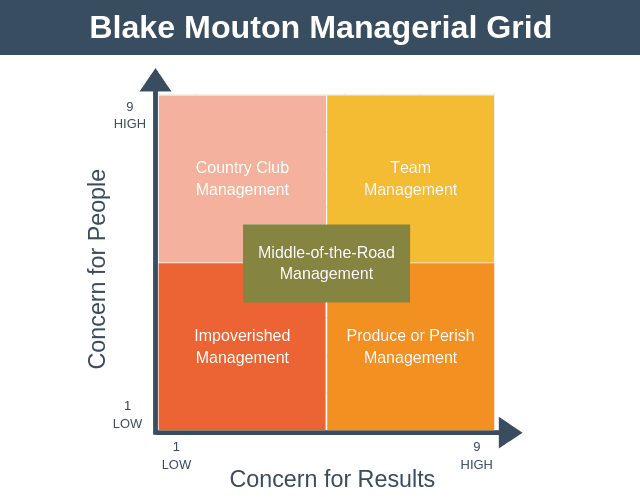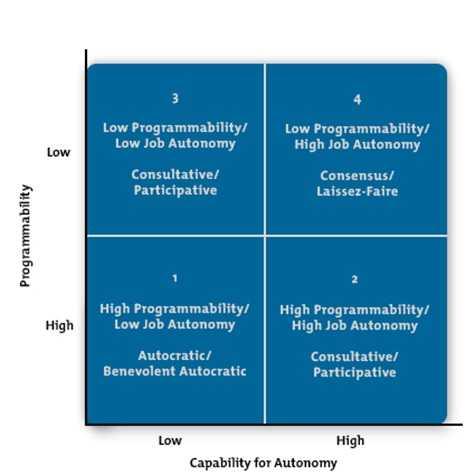Leadership Styles - Choosing the Right Approach for the Situation
Curated from: mindtools.com
Ideas, facts & insights covering these topics:
10 ideas
·18.5K reads
81
2
Explore the World's Best Ideas
Join today and uncover 100+ curated journeys from 50+ topics. Unlock access to our mobile app with extensive features.
Kurt Lewin's Leadership Styles
Psychologist Kurt Lewin developed his framework in the 1930s, and it provided the foundation of many of the approaches that followed afterwards
- Autocratic leaders make decisions without consulting their team members, even if their input would be useful.
- Democratic leaders make the final decisions, but they include team members in the decision-making process.
- Laissez-faire leaders give their team members a lot of freedom in how they do their work. They provide support with resources and advice if needed, but otherwise they don't get involved.
497
2.81K reads
The Blake-Mouton Managerial Grid
- With a people-oriented style, you focus on organizing, supporting, and developing your team members. This participatory style encourages good teamwork and creative collaboration.
- With task-oriented leadership, you focus on getting the job done. You define the work and the roles required, put structures in place, and plan, organize, and monitor work.
The best style to use is one that has both a high concern for people and a high concern for the task.
451
2.21K reads
Path-Goal Theory
With this, you can identify the best leadership approach to use, based on your people's needs, the task that they're doing, and the environment that they're working in.
For example, highly-capable people, who are assigned to a complex task, will need a different leadership approach from people with low ability, who are assigned to an ambiguous task. (The former will want a participative approach, while the latter need to be told what to do.)
411
1.87K reads
Flamholtz and Randle's Leadership Style Matrix
It shows you the best style to use, based on how capable people are of working autonomously, and how creative or "programmable" the task is.
The matrix is divided into four quadrants – each quadrant identifies two possible styles that will be effective for a given situation, ranging from "autocratic/benevolent autocratic" to "consensus/laissez-faire."
456
1.9K reads
Transformational Leadership
Often the most effective style to use.
Transformational leaders have integrity and high emotional intelligence . They motivate people with a shared vision of the future, and they communicate well. They're also typically self-aware , authentic , empathetic , and humble .
504
1.84K reads
Leadership is not a "one size fits all" thing
You must adapt your approach to fit the situation.
This is why it's useful to develop a thorough understanding of other leadership frameworks and styles - the more approaches you're familiar with, the more flexible you can be.
413
1.66K reads
Bureaucratic Leadership
Means following rules rigorously, and ensure that their people follow procedures precisely.
It works for work involving serious safety risks (working with machinery, with toxic substances), or with large sums of money. Bureaucratic leadership is also useful for managing employees who perform routine tasks. Not very effective in teams that rely on creativity, flexibility and innovation.
404
1.45K reads
Charismatic Leadership
Charismatic leaders inspire and motivate their team members. But they often focus on themselves and their own ambitions, and they may not want to change anything.
Charismatic leaders might believe that they can do no wrong, even when others warn them about the path that they're on.
412
1.52K reads
Servant Leadership
A "servant leader " is someone, regardless of level, who leads simply by meeting the needs of the team.
These people often lead by example. They have high integrity and lead with generosity. Their approach can create a positive corporate culture, and it can lead to high morale among team members, but it doesn't work in situations where you have to make quick decisions or meet tight deadlines.
463
1.73K reads
Transactional Leadership
This style starts with the idea that team members agree to obey their leader when they accept a job.
The "transaction" usually involves the organization paying team members in return for their effort and compliance on a short-term task. The leader has a right to "punish" team members if their work doesn't meet an appropriate standard.
It clarifies everyone's roles and responsibilities, but it can be amoral and can lead to high staff turnover
416
1.53K reads
IDEAS CURATED BY
"The pessimist complains about the wind. The optimist expects it to change. The leader adjusts the sails.”- John Maxwell
Valentina M.'s ideas are part of this journey:
Learn more about personaldevelopment with this collection
How to build trust and respect with team members
How to communicate effectively
How to motivate and inspire others
Related collections
Similar ideas
13 ideas
3 ideas
6 Leadership Styles And When You Should Use Them
fastcompany.com
Read & Learn
20x Faster
without
deepstash
with
deepstash
with
deepstash
Personalized microlearning
—
100+ Learning Journeys
—
Access to 200,000+ ideas
—
Access to the mobile app
—
Unlimited idea saving
—
—
Unlimited history
—
—
Unlimited listening to ideas
—
—
Downloading & offline access
—
—
Supercharge your mind with one idea per day
Enter your email and spend 1 minute every day to learn something new.
I agree to receive email updates




